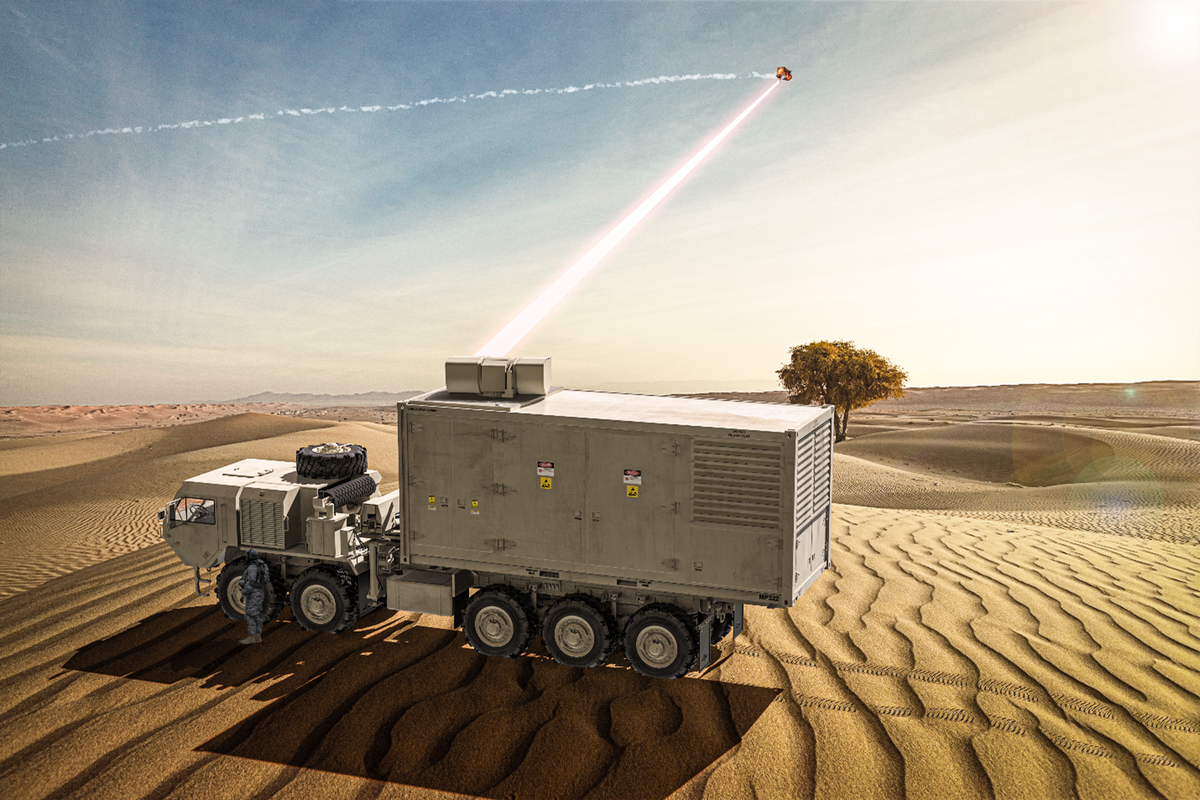Economics Drives Ray-Gun Resurgence
Laser weapons, cheaper by the shot, should work well against drones and cruise missiles

Lockheed Martin's laser packs up to 300 kilowatts—enough to fry a drone or a plane.
The technical challenge of missile defense has been compared with that of hitting a bullet with a bullet. Then there is the still tougher economic challenge of using an expensive interceptor to kill a cheaper target—like hitting a lead bullet with a golden one.
Maybe trouble and money could be saved by shooting down such targets with a laser. Once the system was designed, built, and paid for, the cost per shot would be low. Such considerations led planners at the Pentagon to seek a solution from Lockheed Martin, which has just delivered a 300-kilowatt laser to the U.S. Army. The new weapon combines the output of a large bundle of fiber lasers of varying frequencies to form a single beam of white light. This laser has been undergoing tests in the lab, and it should see its first field trials sometime in 2023. General Atomics, a military contractor in San Diego, is also developing a laser of this power for the Army based on what’s known as the distributed-gain design, which has a single aperture.
This article is part of our special reportTop Tech 2023.
Both systems offer the prospect of being inexpensive to use. The electric bill itself would range “from US $5 to $10,” for a pulse lasting a few seconds, says Michael Perry, the vice president in charge of laser systems for General Atomics.
Why are we getting ray guns only now, more than a century after H.G. Wells imagined them in his sci-fi novel The War of the Worlds? Put it down partly to the rising demand for cheap antimissile defense, but it’s mainly the result of technical advances in high-energy lasers.
The old standby for powerful lasers employed chemical reactions in flowing gas. That method was clumsy, heavy, and dangerous, and the laser itself became a flammable target for enemies to attack. The advantage was that these chemical lasers could be made immensely powerful, a far cry from the puny pulsed ruby lasers that wowed observers back in the 1960s by punching holes in razor blades (at power levels jocularly measured in “gillettes”).
“With lasers, if you can see it, you can kill it.” —Robert Afzal, Lockheed Martin
By 2014, fiber lasers had reached the point where they could be considered for weapons, and one 30-kW model was installed on the USS Ponce, where it demonstrated the ability to shoot down speedboats and small drones at relatively close range. The 300-kW fiber lasers being employed now in the two Army projects emit about 100 kW in optical power, enough to burn through much heftier targets (not to mention quite a few gillettes) at considerable distances.
“A laser of that class can be effective against a wide variety of targets, including cruise missiles, mortars, UAVs, and aircraft,” says Perry. “But not reentry vehicles [launched by ballistic missiles].” Those are the warheads, and to ward them off, he says, you’d probably have to hit the rocket when it’s still in the boost phase, which would mean placing your laser in orbit. Laser tech is still far from performing such a feat.
Even so, these futuristic weapons will no doubt find plenty of applications in today’s world. Israel made news in April by field-testing an airborne antimissile laser called Iron Beam, a play on the name Iron Dome, the missile system it has used to down rockets fired from Gaza. The laser system, reportedly rated at about 100 kW, is still not in service and hasn’t seen combat, but one day it may be able to replace some, if not all, of Iron Dome’s missiles with photons. Other countries have similar capabilities, or say they do. In May, Russia said it had used a laser to incinerate a Ukrainian drone from 5 kilometers away, a claim that Ukraine’s president, Volodymyr Zelenskyy, derided.
The good and bad of directed-energy weapons
A missile is destroyed by a low-power, 2013 version of Lockheed Martin’s fiber laserwww.youtube.com
Not all ray guns must be lasers, though. In March, Taiwan News reported that Chinese researchers had built a microwave weapon that in principle could be placed in orbit from where its 5-megawatt pulses could fry the electronic heart of an enemy satellite. But making such a machine in the lab is quite different from operating it in the field, not to mention in outer space, where supplying power and removing waste heat constitute major problems.
Because lasers performance falls off in bad weather, they can’t be relied on by themselves to defend critically important targets. They must instead be paired with kinetic weapons—missiles or bullets—to create a layered defense system.
“With lasers, if you can see it, you can kill it; typically rain and snow are not big deterrents,” says Robert Afzal, an expert on lasers at Lockheed Martin. “But a thundercloud—that’s hard.”
Afzal says that the higher up a laser is placed, the less interference it will face, but there is a trade-off. “With an airplane you have the least amount of resources—least volume, least weight—that is available to you. On a ship, you have a lot more resources available, but you’re in the maritime atmosphere, which is pretty hazy, so you may need a lot more power to get to the target. And the Army is in between: It deals with closer threats, like rockets and mortars, and they need a deep magazine, because they deal with a lot more targets.”
In every case, the point is to use expensive antimissile missiles only when you must. Israel opted to pursue laser weapons in part because its Iron Dome missiles cost so much more than the unguided, largely homemade rockets they defend against. Some of the military drones that Russia and Ukraine are now flying wouldn’t break the budget of the better-heeled sort of hobbyist. And it would be a Pyrrhic victory indeed to shoot them from the sky with projectiles so costly that you went broke.
This article appears in the January 2023 print issue as “Economics Drives a Ray-Gun Resurgence .”

Top Tech 2023
Top Tech 2023: A Special Report
Preview exciting technical developments for the coming year.
Can This Company Dominate Green Hydrogen?
Fortescue will need more electricity-generating capacity than France.
Pathfinder 1 could herald a new era for zeppelins
A New Way to Speed Up Computing
Blue microLEDs bring optical fiber to the processor.
The Personal-Use eVTOL Is (Almost) Here
Opener’s BlackFly is a pulp-fiction fever dream with wings.
Baidu Will Make an Autonomous EV
Its partnership with Geely aims at full self-driving mode.
China Builds New Breeder Reactors
The power plants could also make weapons-grade plutonium.
Economics Drives a Ray-Gun Resurgence
Lasers should be cheap enough to use against drones.
A Cryptocurrency for the Masses or a Universal ID?
What Worldcoin’s killer app will be is not yet clear.
The company’s Condor chip will boast more than 1,000 qubits.
Vagus-nerve stimulation promises to help treat autoimmune disorders.
New satellites can connect directly to your phone.
The E.U.’s first exascale supercomputer will be built in Germany.
A dozen more tech milestones to watch for in 2023.
- Why Microwave Auditory Effect Crowd-Control Gun Won't Work ›
- Ray Guns Get Real ›
- Fiber Lasers Mean Ray Guns Are Coming ›


